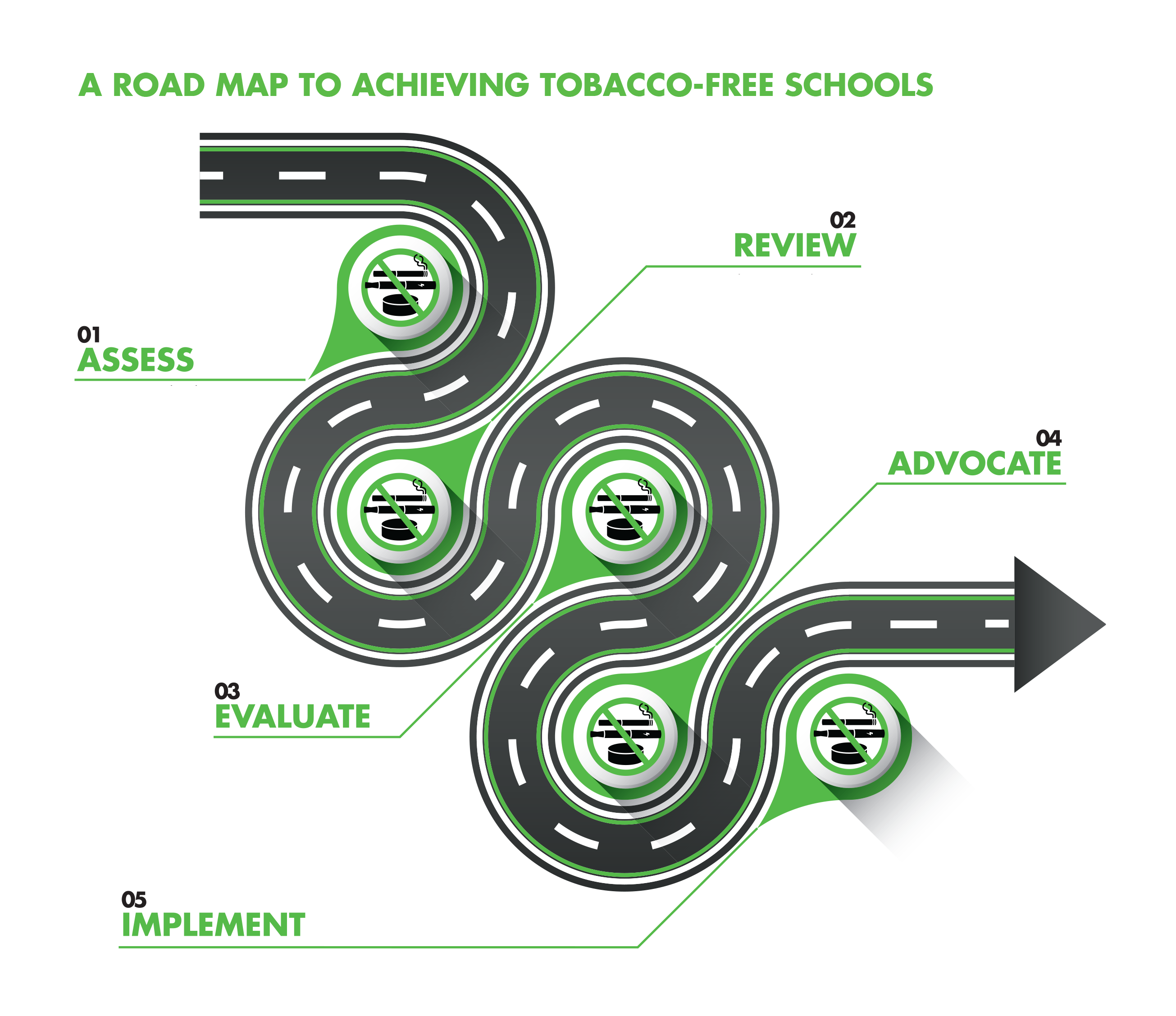Changing your school district’s tobacco policy may seem daunting, but 24/7 is here to provide the tools and resources to make this journey easier, offering support at every turn. Read below to learn more about the road map to achieving 100% tobacco-free school environments in your district.

First, assess your district’s current status. You can use this questionnaire to analyze policy items relating to: tobacco use in your school, on school grounds, and at school event by students, staff, and visitors, having systems and protocol in place for reports of tobacco-free policy violations, the types of tobacco and nicotine products covered under the district’s policy, awareness of the policy, awareness of cessation resources, as well as the cultural competency of the policy and the way it is enforced on campus.
Next, review the comprehensive standard and the 24/7 model tobacco policy, found on our website within the 24/7 toolkit. Then, evaluate your school district’s current tobacco policy to see what items might need to be updated in order to be truly comprehensive and ensure all schools in the district are 100% tobacco-free. 24/7 can also evaluate your district’s policy for you, and offers ongoing support to districts and individual schools in updating, implementing, and enforcing their policies, as desired.
Following this evaluation, if you find your school district’s policy could be stronger, advocate for a new, revised policy by working with your district’s school board. You may find it helpful to ensure commitment by finding other champions within your school or district, including members of the board.
Once the school board has voted to approve a new comprehensive policy, the next step would be to implement your school’s updated tobacco policy, focusing on the following areas:
(1) Communication.
When people know the rules, they are much more likely to comply with a new policy. Communication methods include: posted signage [bi-lingual signs provided for free of cost by 24/7 to all comprehensive districts], announcements at school events, a notification plan to ensure students, staff, and visitors are aware of the policy, and inclusions of the policy in written materials such as printed or digital copies of student & staff handbooks.
(2) Compliance and Enforcement.
It is up to school administration and staff to make sure that rules and consequences are consistently enforced. 24/7 uses progressive and supportive discipline measures for students, as well as progressive discipline for visitors, and offers a variety of resources and sample communication templates in our toolkit, available for free on our website and provided in print to all comprehensive districts.
(3) Cessation Support.
Schools must provide referrals to cessation support services to tobacco or nicotine users who need help quitting. Research has shown that most teen smokers do want to quit but have been unsuccessful in their previous attempts. Because nicotine dependence can start early in an adolescent’s use of tobacco products, cessation resources should be offered to the student beginning at the first offense. No one can be forced to quit. Quitting is a choice that must be made by a tobacco user, whether student or staff. New methods of cessation support using media that youth use most often, like texting and the Internet, are now available. Online support, telephone counseling and text messages can all provide valuable support for teens who would like help with quitting. Specific resources to these services and others can be found in the 24/7 toolkit.
(4) Cultural Competency.
To a great degree, the success of a school’s tobacco-free policy depends on understanding cultural and situational differences among students, especially those most likely to use tobacco products. Areas to consider when implementing and communicating your policy include language, reading level, traditional practices (note: 24/7’s policies do not apply to sacred tobacco. Our policies apply to commercial tobacco only, and we will never prohibit sacred tobacco.), images that reflect the community, type of tobacco products used in the community, and developmental level. Knowledge and appreciation of these differences is essential for creating and enforcing tobacco-free school policies appropriate for the students in our schools and supporting success for the students who are most at risk.
If you would like to learn more about 24/7 and take the next step toward a comprehensive 100% tobacco-free policy for your district, please visit 247newmexico.com or send an email to info@247NewMexico.com.

0 thoughts on “How To Become a Truly Tobacco-Free District: A Guide”
No comments yet
The comments are closed.